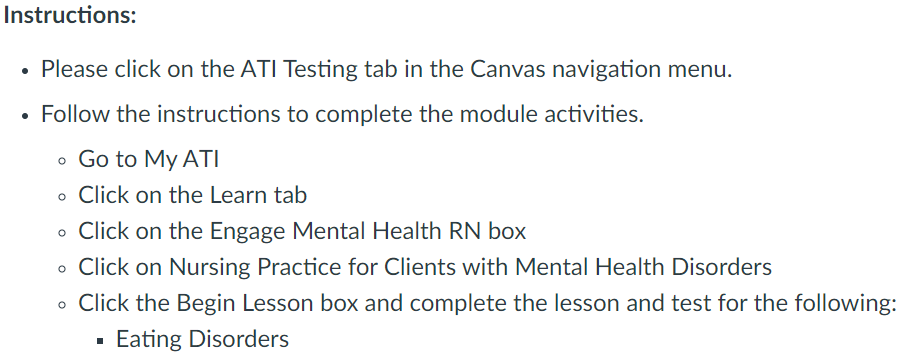NUR105 M5.4: ATI Engage Mental Health: Eating Disorders
Eating disorders are complex mental health conditions that can have serious physical and psychological consequences. They are characterized by unhealthy eating behaviours, often involving extremes of food restriction, binge eating, or purging. Below are key points about various eating disorders:
Anorexia Nervosa:NUR105 M5.4: ATI Engage Mental Health
This disorder involves persistent energy intake restriction leading to significantly low body weight.
Individuals with anorexia have an extreme fear of gaining weight and often perceive themselves as overweight, even if they are underweight.
Anorexia nervosa typically begins in adolescence to young adulthood and is associated with preoccupation with food and a refusal to eat.
Two subtypes are recognized: restricting type (food intake restriction without binge/purge) and binge-eating/purging type (engaging in binge eating or purging behaviors).
Bulimia Nervosa:
Bulimia involves recurrent episodes of eating large amounts of food within a short period (binge eating) followed by inappropriate compensatory behaviors such as self-induced vomiting or laxative use.
These compensatory behaviors occur on average at least once a week for three months.
Individuals with bulimia usually maintain their weight within a normal range or slightly higher.
Onset typically occurs in late adolescence or early adulthood, and it predominantly affects females.
Bulimia can be classified into purging type (using self-induced vomiting or laxatives) and non-purging type (compensating through means like excessive exercise).
Binge Eating Disorder (BED):NUR105 M5.4: ATI Engage Mental Health
Unlike bulimia, BED does not involve compensatory behaviors.
It is characterized by recurrent episodes of eating large amounts of food within a short period (binge eating) at least once a week for three months.
BED affects individuals of all ages but is most common in adults aged 46-55.
Weight gain is often associated with BED, increasing the risk of conditions like type 2 diabetes, hypertension, and cancer.
Common Risk Factors for Eating Disorders:NUR105 M5.4: ATI Engage Mental Health
Occupational choices (e.g., modeling).
History of being a “picky” eater in childhood.
Participation in sports or activities emphasizing lean body build or weight control.
Family genetics, biological, psychological, and environmental factors.
History of obesity.
Interpersonal and psychological influences.
Nursing Considerations:
Nurses should gather a comprehensive history from patients with eating disorders, including eating habits, dieting history, methods of weight control, and psychological factors.
It’s crucial to assess patients for cognitive distortions, which are common in individuals with eating disorders. These distortions can include overgeneralizations, “all-or-nothing” thinking, catastrophizing, personalization, and emotional reasoning.
Expected findings in patients with eating disorders include cognitive distortions, fear of gaining weight, preoccupation with food, and low self-esteem. Patients may also exhibit ritualistic behaviours related to eating and a need for an intense physical regimen.
Vital signs may reveal low blood pressure, decreased heart rate, and temperature. In individuals with BED, hypertension may be present.
Physical findings can include fine, downy hair on the face and back (lanugo), yellowed skin, calluses or scars on the hand from self-induced vomiting, and muscle weakness.
Criteria for Acute Care Treatment:
Rapid weight loss or loss greater than 30% of body weight over six months.
Unsuccessful weight gain in outpatient treatment or failure to adhere to treatment.
Vital signs indicating severe heart rate and blood pressure abnormalities.
Electrolyte disturbances.
Severe psychiatric symptoms such as severe depression, suicidal behavior, or psychosis.
Common Lab Abnormalities in Anorexia Nervosa:
Hypokalemia (due to purging and dehydration).
Anemia, leukopenia, thrombocytopenia.
Impaired liver function with increased enzyme levels.
Hypoalbuminemia.
Elevated cholesterol.
Elevated BUN (related to dehydration).
Abnormal thyroid function tests.
Elevated carotene levels (causing yellow skin).
Decreased bone density (possible osteoporosis).
Abnormal blood glucose levels.
ECG changes, including a prolonged QT interval.
Abnormal serum bicarbonate levels (either metabolic alkalosis due to self-induced vomiting or metabolic acidosis due to laxative use).NUR105 M5.4: ATI Engage Mental Health
If you’re preparing for ATI testing or the NCLEX exam and need assistance or additional guidance, please consider our service at fixmygpa.com. We provide support and resources to help you succeed in your nursing career and exams. Don’t hesitate to reach out and take the next step toward achieving your academic and professional goals.



